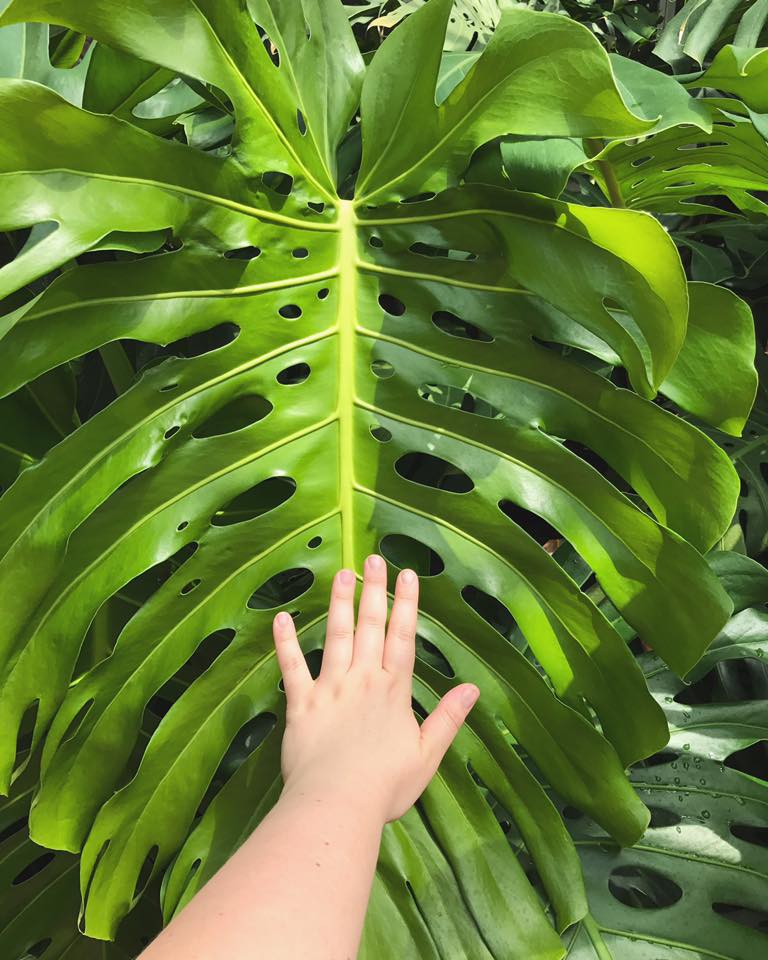Plant profile: Monstera deliciosa
A new leaf from a mature Monstera deliciosa plant.
I figured I'd dedicate my first plant profile to my favorite plant in the whole wide world: Monstera deliciosa. This is THE PLANT that started my deep love for all things flora, and it will forever hold a special place in my heart. Affectionately called a swiss cheese plant due to the holes and splits in its leaves, the monstera plant enjoyed popularity in the mid-20th century, and is currently a very trendy plant again in 2017. The iconic leaves can be found printed on everything from bed sheets (ahem, I may or may not have some monstera sheets), tennis shoes, shower curtains, and dresses. It even has its own hashtag on Instagram: #monsteramonday! Monstera is definitely having a moment, and deservedly so. I have found it to be a wonderfully resilient and versatile plant that is actually quite suitable for budding green thumbs.
Biology: Monstera deliciosa is native to Mexico and can be found climbing up trees in the wilds tropical locations like Hawaii and Florida as well. It's technically an "epiphyte," meaning it grows on other plants and produces aerial roots; orchids and tillandsia species (aka air plants) are also epiphytes! Cool, huh? The aerial roots absorb nutrients from the surrounding air in the environment, and also help the monstera attach more easily to trees. M. deliciosa is part of the Araceae family, so it's related to common houseplants like the peace lily (Spathiphyllum wallisii), golden pothos (Epipremnum aureum), and heart leaf philodendron (Philodendron hederaceum). In the right conditions, M. deliciosa will flower and produce a blossom with a "spadix" that looks like a cone with tiny flowers encased in a cupped sheath called a "spathe." If you've ever seen a peace lily bloom, that's similar to what a Monstera flower looks like... they are cousins, after all! In the wild, the monstera is also known to bear fruit, however that is quite rare indoors. The fruit is commonly eaten in Mexico and is said to taste like pineapple. I don't know about you, but I would LOVE to try it.
Lighting: Monstera deliciosa is a plant that tolerates a wide level of light ranges, but does best in bright, indirect light. The more light a monstera receives, the larger the leaves will become and more splits and holes the leaves will develop. These splits and holes are called "fenestrations" and allow the plant to withstand strong winds in the wild. Monstera will still produce plenty of new growth in more moderate light, but they won't have the iconic fenestrations that make the plant so unique in the first place. The leaves may also stay on the smaller side and remain heart-shaped. If you notice your plant becoming leggy or notice that new growth is small and without fenestrations, play around with brighter light or artificial lighting. Try to keep it out of very direct light or it could get sunburned!
Watering: Again, monstera is a pretty hardy plant and is quite forgiving if you forget to water it here and there. Typically, I let at least the top 2 inches of soil dry out between waterings, then drench thoroughly. Make sure the soil has excellent drainage (no pots without holes, I say!) and aerate the soil often. Soil tends to compact as you water it, so aerating helps to loosen the soil and allows for the water to reach the roots more quickly. If your monstera starts to wilt, water it STAT! Your monstera should also be just fine with standard tap water, but if you have access to rain water or distilled water, I believe that is always the best choice regardless of the plant!
Humidity + temperature: Keep in mind that Monstera deliciosa is a tropical plant (as are a large portion of indoor houseplants), so it thrives in the warmer temperatures and high humidity that mimic it's natural jungle environment. Don't fret if you don't live in a humid climate, though: monstera can tolerate regular household humidity just fine. If you feel like the air is quite dry, however, there are many ways to increase the humidity in the surrounding environment. (Keep your eyes peeled for an entire post about this soon!) Monstera can also deal with cooler temperatures down into 60 degrees Fahrenheit, but try to keep it away from blast of cold air from your AC. Monsteras are typically happy outside in the shade during the spring and summer.
Soil + fertilizer: Almost any nutrient-dense, rich potting soil is a good choice for Monstera deliciosa. My favorite brands are Black Gold and Fox Farms, which you can find on Amazon. If you want to take your potting medium to the next level and really treat your monstera like the royalty it is, try this mix that I use: 30% soil, 20% peat moss, 40% orchid bark, and 10% perlite. You can also toss in a handful of charcoal and finely-shredded spaghum moss as well. The idea is that this mix drains the water very well, but still retains some moisture so that it's damp, but not soggy. You can feed your monstera with a balanced fertilizer every 2-4 weeks during growing season (i.e. spring and summer) and every month or other month during fall and winter, as long as your plant is still producing new growth! Which it likely will, because monstera is a fast grower!
Repotting: Repot into a container 2-4" larger when the roots start bulging over the top of the soil, or when they sneak out of the drainage holes. Repotting is also the best time to attach your monstera to a moss pole or trellis to climb. Remember, these plants climb in nature, so it's their inclination to grow UP something. Monstera can get unruly if left unattached to something that will support it.

